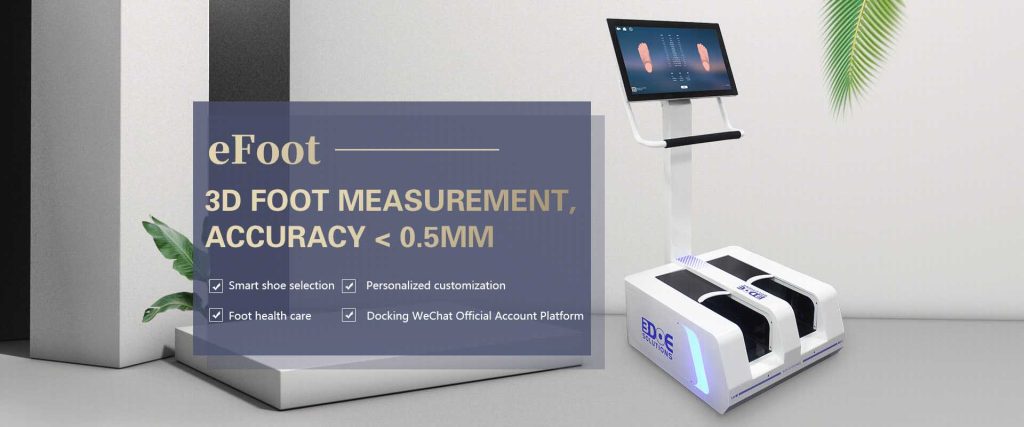Foot Health: An Essential Part of Overall Wellness
Foot health is a crucial component of overall health, yet many people tend to overlook it until noticeable discomfort or disease arises. Today, with rapid advancements in medical technology, 3D foot scanners have emerged as vital tools for the quick diagnosis of foot-related conditions. This cutting-edge technology provides precise foot data, offering scientific support for clinical diagnosis and treatment, helping patients recover faster. Whether it’s common issues like plantar fasciitis or more complex foot deformities, 3D foot scanners play an irreplaceable role.
What is a 3D Foot Scanner?
A 3D foot scanner is a high-precision device that uses three-dimensional scanning technology to capture comprehensive data about foot shape, pressure distribution, and dynamic movement. This information quickly identifies the root cause of foot problems, enabling doctors to create personalized treatment plans and enhancing diagnostic and treatment efficiency.
Common Types of Foot Diseases
Foot diseases are diverse and often present subtle symptoms in their early stages. Over time, however, they can lead to more severe issues. Here are some common types:
- Plantar Fasciitis
Inflammation of the plantar fascia often results in heel pain, especially in the morning or after prolonged sitting. - Bunions (Hallux Valgus)
The big toe deviates from its normal position, leading to joint deformity and, in severe cases, difficulty walking. - Flat Feet and High Arches
Abnormal arch shapes can cause uneven pressure distribution during walking, resulting in foot pain or other complications. - Diabetic Foot
People with diabetes are prone to foot ulcers and infections due to nerve damage and poor circulation. - Fractures or Stress Injuries
Excessive activity or external impact can cause mild to severe foot bone injuries.

Applications of 3D Foot Scanners
1. Precise Measurement of Foot Morphology
3D foot scanners capture the three-dimensional shape of the foot, providing detailed structural data such as length, width, and height. This information is crucial for the early diagnosis of conditions like bunions and arch abnormalities.
2. Analysis of Foot Pressure Distribution
The scanner records the pressure distribution across different areas of the foot. For instance, in diagnosing plantar fasciitis, high-pressure zones are often located in the heel, providing a clear reference for doctors.
3. Dynamic Gait Analysis
By dynamically scanning patients during walking, the device identifies gait patterns, which are essential for diagnosing dynamic issues like flat feet or high arches and assessing potential risks of sports injuries.
4. Early Detection of Problems
Many foot diseases may not show noticeable symptoms in their early stages. 3D scanning data can identify potential issues, allowing for preventive measures to be taken.
5. Personalized Treatment Plans
Doctors can use scanning data to design tailored treatment plans, such as orthotic insoles or physical therapy programs, improving treatment effectiveness.
Clinical Case Studies
Case 1: Early Diagnosis of Bunions
A 40-year-old woman experienced mild foot discomfort due to prolonged high-heel usage. A 3D foot scan revealed early-stage bunions affecting foot structure. Customized insoles based on the scan data alleviated her symptoms and prevented further progression.
Case 2: Prevention of Diabetic Foot Ulcers
A diabetic patient’s 3D scan highlighted high-pressure areas on the sole, indicating a risk of ulcers. Adjustments to insole design effectively redistributed pressure, preventing ulcer development.
Case 3: Diagnosing Sports Injuries in Athletes
A runner with recurring ankle pain underwent a 3D foot scan, which revealed low arches causing pressure concentration on the foot’s inner side. Supportive insoles and training modifications resolved the issue.
How to Use a 3D Foot Scanner in Treatment
1. Rapid Data Collection
The scanning process takes only a few seconds, generating a complete 3D foot model and a detailed analysis report.
2. Accurate Treatment Planning
Whether selecting the right orthotic insoles or creating a physical therapy plan, scanner data provides precise references for doctors.
3. Monitoring Treatment Outcomes
Regular scans during treatment help track changes in the foot, allowing for adjustments to the treatment plan as needed.
4. Preventing Recurrence
By analyzing gait and pressure distribution, patients can understand behaviors that might lead to recurring conditions and take preventive actions.
Advantages of 3D Foot Scanners
- Speed and Efficiency: Scanning takes only seconds, saving time for doctors and patients.
- Non-invasive: The device doesn’t require direct skin contact, making it suitable for all individuals.
- High Precision: 3D data provides detailed insights into every aspect of the foot, supporting scientific diagnosis.
- Versatility: Applications range from medical diagnosis and sports rehabilitation to footwear design.
Future Development Trends
With ongoing technological advancements, 3D foot scanners are becoming more intelligent and accessible. For instance, portable scanners may soon be available for home use, and AI-powered analysis will further enhance diagnostic accuracy and efficiency.
